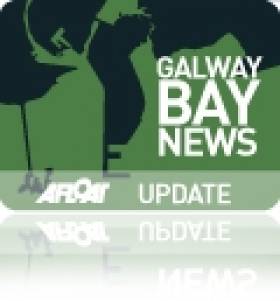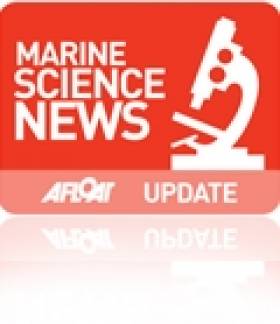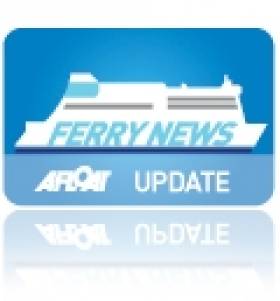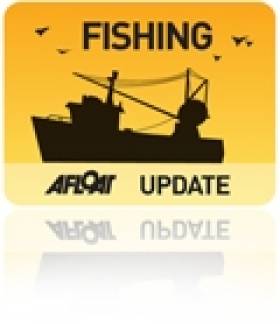Displaying items by tag: Galway Bay
Salthill Apartment With Excellent Views Of Galway Bay
#WaterfrontProperty - Spectacular views of Galway Bay are just one attraction of a spacious two-bed apartment now on the market in Salthill.
Boasting a dual aspect over the water and Galway Golf Club, 26 Dun na Carraige is located in an exclusive development on mature landscaped grounds adjacent to the beauty of Salthill's promenade - and only a short distance from Galway city centre.
The second-floor apartment itself is fitted with semi-solid oak floors in the hall and open-plan living/dining area, a fitted kitchen with granite worktops, plus a tiled bathroom and en-suite, the latter serving one of two double bedrooms, and balconies to the front and rear.
Mullery Auctioneers says the property would make and idea home or retirement home, or even a weekend retreat considering the wealth of local amenities.
26 Dun na Carraige is on the market for €275,000 and viewing is by appointment only through Mullery Auctioneers. For more details see HERE.
Disabled Sailing Nationals In Galway Bay For 2014
#GalwayBay - Galway Bay Sailing Club (GBSC) will host the 2014 National Disabled Sailing Championships, it has been announced.
According to the Galway Advertiser, the decision to give the event to the City of the Tribes was swayed by its successful Access sailing programme for young people with disabilities.
IFDS president John Twomey - also Afloat.ie's Sailor of the Month for August - was in the city recently to see some of those young sailors compete at the helm of Hansa 303 dinghies in GBSC's first Access Autumn Series.
The series features members of the Galway Speeders, a sports club set up for young people with disabilities that's currently seeking funding for equipment that will help its sailors get in and out of their boats more easily.
The Galway Advertiser has more on the story HERE.
#FishFarm - The Marine Institute has moved to highlight what it says are a "number of inaccuracies" in a news story regarding plans for the controversial Galway Bay fish farm.
Yesterday (15 August) TheJournal.ie published an article on An Taisce's criticism of a Marine Institute-sponsored study being used to support the case for Bord Iascaigh Mhara's (BIM) planned organic salmon farm, which has faced much opposition from environmentalists and local anglers.
In a statement quoted by the news website, the State's national trust referred to a recently published research paper from the University of Toronto that is said to identify "fundamental errors" in the Marine Institute study.
The Marine Institute today hit back at TheJournal.ie's claims, stating that the study in question is a scientific paper published in the Journal of Fish Diseases and "is not connected to the BIM proposal for a fish farm in Galway Bay".
The study, it adds, is based on data collected from eight locations around the Irish coast between 2001 and 2009, and concludes that the impact of sea lice on wild salmon is "unlikely to be a significant factor" in their mortality rates.
However, last month Inland Fisheries Ireland expressed "serious concerns" over the findings - and the Marine Institute concedes that it will consider the new research from Toronto that questions the methodology of the study.
Galway Bay Fast Ferry Returns For Two-Week Trial
#GalwayBay - The Ballyvaughan Bay Hop fast ferry service between Galway and Clare will return for a two-week trial this September, as the Galway Independent reports.
Last year the ferry link across Galway Bay from Ballyvaughan in Co Clare to Galway city was trialled to coincide with the Volvo Ocean Race finale and the increased demand for access to the city during the festivities.
This year's trial - using a 12-passenger hard cabin RIB from O'Brien Lines - is intended to access the viability of a permanent fast ferry link across the bay, and how it might integrate with existing local bus and other transport services.
Similar to last summer's service, 10-journey tickets will be on sale for passengers to make a saving, and a special early bird discount is available till 23 August. For more see the Ballyvaughan Bay Hop website HERE.
Galway Bay Charity Swimmers Raise €80,000
#GalwayBay - Even swarms of jellyfish weren't enough to stop the more than 50 swimmers who took a dip for a good cause in the eighth annual Frances Thornton Memorial Galway Swim last weekend.
As the Irish Independent reports, hundreds were lined up at Blackrock Tower in Salthill on Saturday 27 July to welcome the swimmers at the end of their 13km open sea swim from Aughinish in Co Clare on the south shore of Galway Bay.
And together they raised some €80,000 for Cancer Care West, bringing the total over all eight swims to almost half a million euro.
The Irish Independent has more on the story HERE.
#FishFarm - Bord Iascaigh Mhara (BIM) has responded to concerns from environmental groups that an ingredient in treatments for sea lice in salmon farms poses a threat to wild marine life.
As Galway Bay FM reports, campaigners Galway Bay Against Salmon Cages - one of the groups opposed to the planned Galway Bay fish farm - say that cypermethrin, an active ingredient in veterinary medicine used to treat sea lice, is toxic to aquatic organisms.
BIM aquaculture manager Donal Maguire attempted to play down fears over the use of the pesticide, saying it has been fully tested for toxicology in the marine environment.
However, another campaign group claims BIM's position is contrary to the manufacturer's own warnings on the use of the drug.
According to FishNews.eu, Friends of the Irish Environment (FIE) cited the Irish Medicines Board's product description for cypermethrin, which states that it is "dangerous to fish and other aquatic life" and demands that the chemical "should not be allowed to contaminate water".
FIE went on to describe cypermethrin as "a biocide which kills life, not a medicine that saves lives" and as "a highly active neurotoxin" with "known effects on fish and, most sensitive of all, crustaceans such as crabs and lobsters. Bathers and watersports [enthusiasts] may also be at risk."
Earlier this month, Inland Fisheries Ireland (IFI) expressed "serious concerns" over the findings of a study on wild salmon in Ireland that claimed fish farm schemes were less harmful to wild fish than pollution and possibly even beneficial to wild catchments.
IFI is among the significant opposition to BIM's proposed organic salmon farm off the Aran Islands, a 500-hectare project that would be the largest of its kind in Europe and create hundreds of jobs in the locality.
#sb20 – This Friday sees the kick off for the 2013 SB20 Nationals, this year hosted by Galway Bay Sailing Club, Galway Harbour Company and race HQ provided by the Harbour Hotel.
The fleet are well used to Galway Bay having had 3 previous Western Championships run from the city centre docks location. Galway has proven an ideal location for the fleet as it provides good deep water marina berthing, on-site crane and perfect Atlantic sailing.
The Irish SB20 fleet is still one of the most competitive and thriving SB20 Fleets in the world.
It is a measure of this success which warrants a visit from the SB20 World Council President Ed Russo, to compete in his run up campaign to the SB20 Worlds to be held in September in Hyeres in the South of France. Of the 90 boats entered so far to the French spectacular, over 10% of these entries come from the Irish fleet.
Ed is going to find it tough at the top end of the fleet in this dog eat dog environment where the last two events have gone down to tied points at the lead and count back wins. Alan Hillman of Sportsboat world is putting in an appearance on Friday also to see what the fuss is about.
As usual, Ben Duncan (Sharkbait) and crew will be a force to be reckoned with as they've won the last two nationals and won here three times in a row, but the Kiwi native hasn't had it all his own way this year. John O'Driscoll (Boomchickawahwah) from RSGYC has really been on form and only a quick tack away from winning the Westerns and Southerns this year. Each event going to tied points with Duncan. John and crew also had a good event at the recent Volvo Dun Laoghaire regatta coming second to club mate Michael O'Connor on "Should Be". But can Michael convert "should be" to "could be" for the nationals? Certainly based on his dominance at VDLR 2013 we would have to say yes he could. Michael has had an unlucky start to his SB20 career with some damage but hopefully he can now concentrate on matters at hand and prove to be a force in the class.
On recent form a number of contenders will be well in with a chance at the title. Emmet Ryan's recent successes at the RS400 circuit and a good showing at VDLR for example. Aidan O'Connell who won the Eastern title at Howth, Mel Collins, Kieran Dorgan, Darren Martin all have their eyes on the title but at the end of the day it'll be a numbers game and a top 5 slot in the Irish fleet is a hard place to be. Ed Russo needs his jousting gloves on for this one.
Racing starts on Friday with 3 races scheduled. Conditions at the moment are light to variable so it should be a technically challenging event for all 25 boats expected to cross the starting line.
#Fishing - The Irish Times reports that Inland Fisheries Ireland (IFI) has expressed "serious concerns" over the findings of a new study on wild salmon in Ireland.
The State agency for Ireland's fisheries argues that the study - which concluded not only that pollution has a greater impact on wild salmon numbers than fish farming, but also that salmon catchments in close proximity to aquaculture schemes were some of the best performing - is based on flawed methodology.
IFI is among the chorus of voices opposed to the planned organic salmon farm off the Aran Islands in Galway Bay - a 500-hectare project by Bord Iascaigh Mhara (BIM) that would be the largest of its kind in Europe if given the go-ahead.
Marine Minister Simon Coveney recently attempted to alleviate concerns over the controversial scheme, claiming there would be no damage to the environment or fish stocks.
However, the controversy doesn't end there, as last month celebrity chef and 'Slow Food' champion Darina Allen wrote to the minister over erroneous claims in BIM's environmental impact statement (EIS) for the project.
As reported by the Galway Independent, Allen contacted Minister Coveney to clarify that the Slow Food movement does not support fish farming projects, after references to the initiative in the EIS "seemed to create a lot of confusion".
Allen told the paper: “Many people contacted me under the perception that Slow Food endorsed the whole salmon farm thing and actually Slow Food has made no statement whatsoever on it.”
Later, Michèle Mesmain of Slow Food International confirmed that “salmon farming does not fit in any pillar of Slow Food”.
The Galway Independent has much more on the story HERE.
#WaterfrontProperty - The Galway Independent highlights a "modern luxury home" on the market in Oranmore, Co Galway that might tempt anyone with a longing for the sea.
The 2,600 sq ft four-bed home at 19 Oran Island lies on the eastern edge of Galway Bay and its breathtaking vistas.
A short drive from Galway city proper, it's also within walking distance of Oranmore village and Galway Bay Sailing Club.
The house is ready to move into, and comprises a tiled entrance hall, living room, kitchen/diner, study, utility room and sunroom, plus four bedrooms (two en-suite) and a master bathroom on the first floor, and a converted attic space.
The detached home is on a quiet cul-de-sac and comes with an enclosed rear garden and patio area, making the perfect home for a family.
19 Oran Island has an asking price of €380,000 and is available to view through agents O'Donnellan & Joyce. For more on the property click HERE.
Galway Windsurfers Set Paddle Board Record
#Surfing - A trio of Galway windsurfers completed the 95km round trip to and from the Aran Islands last weekend - setting a new Irish record for stand-up paddle boarding in the process.
The Irish Times reports on the successful adventure by Dan Gardner, Daniel King and Joe Gallagher, who embarked on the challenge to raise funds for the Galway RNLI lifeboat service.
Setting out before 5.30am on the morning of Saturday 8 June, they returned to the Galway Docks before 11pm that night - stopping at the halfway mark for lunch on Inis Mór.
The trio are each believed to have covered some 4,000 strokes an hour to make their record time of 17 hours 33 minutes. The Irish Times has more on the story HERE.
In other surfing news, the Sunday Independent reports on a website that's seeking to connect surfers of all levels with the right waves for them.
Waterford-based Liam Sinnott set up Swellseekers.ie with business partner James Hassey two years ago, filling a gap in the market for booking surfing trips online at a time when Ireland was only just emerging as a world-class surfing destination.
Though the site currently only takes bookings for surfing and other watersports in the Waterford area, Sinnott says he hopes to expand his site's scope nationwide by next year to serve a growing wave-riding community of "50,000 surfing all year round".






































































